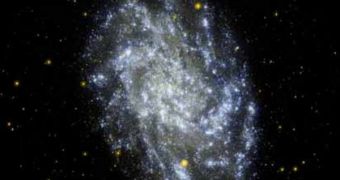Astronomers in the United States focused a recent investigation on a very peculiar space body, that is not at all remarkable in the visible light portion of the electromagnetic spectrum, but which shines incredibly bright in the mid-infrared spectrum.
This unusual star is located in the Triangulum Galaxy (M33), and is completely unremarkable unless viewed in specific wavelengths. However, when the correct filters are used, it becomes the brightest single infrared source in the galaxy.
Ohio State University (OSU) expert Rubab Khan led a team of colleagues in the new investigation, which he says may also be useful for understanding a supernova event that was discovered in 2008.
Back on February 1, two years ago, a star in the Fireworks Galaxy (NGC 6946) went supernova, in an event dubbed 2008S. When astronomers discovered the phenomenon, they turned to archival images of the progenitor star, in order to get more insight into its development.
But images snapped with the Large Binocular Telescope (LBT) found no star that could be qualified as a supernova progenitor. In optical wavelengths, none of the stars stood out.
A breakthrough came when experts decided to use the NASA Spitzer infrared observatory to scan the area. An object immediately stood out, that was extremely bright in mid-infrared wavelengths.
One of the most important conclusions of the Spitzer study was that the star that caused the supernova event was a low-mass one, a discovery that led many to propose that SN 2008S was not a real event.
Others proposed that it was not a supernova, but rather the eruption of a Luminous Blue Variable (LBV) star. However, these objects are very massive, which is not what Spitzer revealed.
But most of the scientists agreed that the progenitor star may have been surrounded by a large amount of dust. As such, astronomers have been searching for similar stars, that would prove their theory.
M33's Object X proved to be an excellent study target. Scientists cross-referenced new data with info from the Local Group Galaxies Survey. Astronomers now believe that the object is a self-obscured star that lost a lot of mass relatively recent.
After shedding it, the material cooled and solidified into graphite or silicate dust, which created a dust envelope around the star. Experts now classify the star as a cool hypergiant, Universe Today reports.
In the next few decades, the star should become visible again, experts say, given that frequent eruptions are stirring up the dust envelope, pushing it further away.
Eventually, it will disintegrate, allowing the object it now hides to shine in the visible portion of the electromagnetic spectrum.

 14 DAY TRIAL //
14 DAY TRIAL //